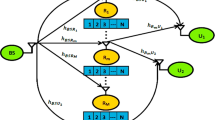Abstract
In this paper, we consider bidirectional decode-and-forward buffer-aided relay selection and transmission power allocation schemes for underlay cognitive radio relay networks. First, a low complexity delay-constrained bidirectional relaying protocol is proposed. The proposed protocol maximizes the single-hop normalized sum of the primary network (PN) and secondary network (SN) rates and controls the maximum packet delay caused by physical layer buffering at relays. Second, optimal transmission power expressions that maximize the single-hop normalized sum rate are derived for each possible transmission mode. Simulation results are provided to evaluate the performance of the proposed relaying protocol and transmission power allocation scheme and compare their performance with that of the optimal scenario. Additionally, the impacts of several system parameters including maximum buffer size, interference threshold, maximum packet delay and number of relays on the network performance are also investigated. The results reveal that the proposed bidirectional relaying protocol and antenna transmission power allocation schemes introduce a satisfactory performance with much lower complexity compared to the optimal relay selection and power allocation schemes and provide an application dependent delay-controlling mechanism. It is also found that the network performance degrades as the delay constraint is more restricted until it matches the performance of conventional unbuffered relaying with delay constraints of three. Additionally, findings show that using buffer-aided relaying significantly enhances the SN performance while slightly weakens the performance of the PN.







Similar content being viewed by others
Notes
Most of the previous works in the literature used the symmetric channel gain assumption to simplify the analysis without any effect on the final results and conclusions of the analysis [12].
The channel information of the primary and secondary users can be possessed by exchanging of channel information with a band manager or central unit [18].
References
Jamali, V., Zlatanov, N., Ikhlef, A., & Schober, R. (2014). Achievable rate region of the bidirectional buffer-aided relay channel with block fading. IEEE Transactions on Information Theory, 60(11), 7090–7111.
Goldsmith, A., Jafar, S., Maric, I., & Srinivasa, S. (2009). Breaking spectrum gridlock with cognitive radios: An information theoretic perspective. Proceedings of the IEEE, 97(5), 894–914.
Tajer, A., Prasad, N., & Xiaodong, W. (2010). Beamforming and rate allocation in MISO cognitive radio networks. IEEE Transactions on Signal Processing, 58(1), 362–377.
Wang, Z., & Zhang, W. (2013). Spectrum sharing with limited channel feedback. IEEE Transactions on Wireless Communications, 12(5), 2524–2532.
Al-Eryani, Y. F., Salhab, A. M., & Zummo, S. A. (2017). An efficient relay selection and power allocation schemes for cognitive MIMO DF relay networks with buffers. Arabian Journal for Science and Engineering, 42(7), 2839–2849.
Bing, X., Yijia, F., Thompson, J., & Poor, H. V. (2008). Buffering in a three-node relay network. IEEE Transactions on Wireless Communications, 7(11), 4492–4496.
Li, L., Zhou, X., Xu, H., Li, G., Wang, D., & Soong, A. (2011). Simplified relay selection and power allocation in cooperative cognitive radio systems. IEEE Transactions on Wireless Communications, 10(1), 33–36.
Luo, C., Yu, F., Ji, H., & Leung, V. (2010). Distributed relay selection and power control in cognitive radio networks with cooperative transmission. In IEEE International Conference on Communications (ICC 12), Kuala Lumpur, Malaysia (pp. 1–5).
Zlatanov, N., Ikhlef, A., Islam, T., & Schober, R. (2014). Buffer-aided cooperative communications: Opportunities and challenges. IEEE Communications Magazine, 52(4), 146–153.
Wu, Y., Chou, P. A., & Kung, S.-Y. (2005). Information exchange in wireless networks with network coding and physical-layer broadcast. In European Conference on Information Systems (ECIS), Germany.
Rankov, B., & Wittneben, A. (2005). Spectral efficient signaling for half-duplex relay channels. In Proceedings of Asilomar Conference on Signals, Systems and Computers, Canada (pp. 1066–1071).
Liu, H., Popovski, P., Carvalho, E., & Zhao, Y. (2013). Sum-rate optimization in a two-way relay network with buffering. IEEE Communications Letters, 17(1), 95–98.
Jamali, V., Zlatanov, N., Ikhlef, A., & Schober, R. (2013). Adaptive mode selection in bidirectional buffer-aided relay networks with fixed transmit powers. In Proceedings of the 21st European Signal Processing Conference (EUSIPCO), Morocco (pp. 1–5).
Jamali, V., Zlatanov, N., Ikhlef, A., & Schobert, R. (2013). Adaptive mode selection and power allocation in bidirectional buffer-aided relay networks. In IEEE Global Communications Conference (GLOBECOM), USA (pp. 1933–1938).
Jamali, V., Zlatanov, N., & Schober, R. (2014). Bidirectional buffer-aided relay networks with fixed rate transmission—Part II: Delay-constrained case. IEEE Transactions on Wireless Communications, 7(99), 1–1.
Tian, Z., Chen, G., Gong, Y., Chen, Z., & Chambers, J. (2015). Buffer-aided max-link relay selection in amplify-and-forward cooperative networks. IEEE Transactions on Vehicular Technology, 64(2), 553–565.
Zlatanov, N., Ikhlef, A., Islam, T., & Schober, R. (2014). Buffer-aided cooperative communications: Opportunities and challenges. IEEE Communications Magazine, 52(4), 146–153.
Ghasemi, A., & Sousa, E. (2007). Fundamental limits of spectrum-sharing in fading environments. IEEE Transactions on Wireless Communications, 6(2), 649–658.
Boyd, S. P., & Vandenberghe, L. (2004). Convex optimization. Cambridge, England: Cambridge University Press.
Yu, W., & Lui, R. (2006). Dual methods for nonconvex spectrum optimization of multicarrier systems. IEEE Transactions on Communications, 54(7), 1310–1322.
Author information
Authors and Affiliations
Corresponding author
Rights and permissions
About this article
Cite this article
Al-Eryani, Y.F., Salhab, A.M. & Zummo, S.A. Cognitive Bidirectional Buffer-Aided DF Relay Networks: Protocol design and Power Allocation. Wireless Pers Commun 97, 5213–5228 (2017). https://doi.org/10.1007/s11277-017-4776-0
Published:
Issue Date:
DOI: https://doi.org/10.1007/s11277-017-4776-0




